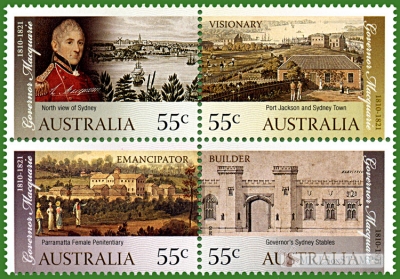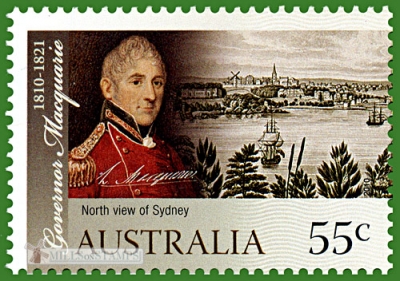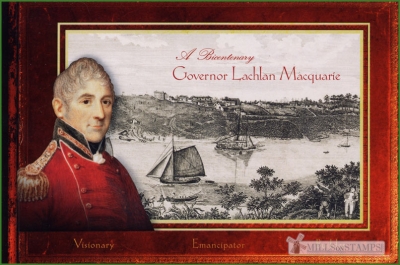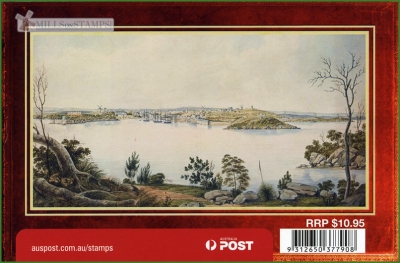-
A Bicentenary: Governor Lachlan Macquarie
Australia 2010.02.16
In issue: Stamp(s): 4 Booklet(s): 1
Printing: Lithography
Issued in: sheets of 50 (25+25) stamps and gutter-strip on the middle
-
Perforation type: 14 ½x13 ¾
Subject:
55 cents. Major-General Lachlan Macquarie* on background of North view of Sydney
Additional:
The stamp and gutter-strip of a sheet contains a reproduction of a lithography of Joseph Lycett '"North view of Sydney".
The original is in National library of Australia.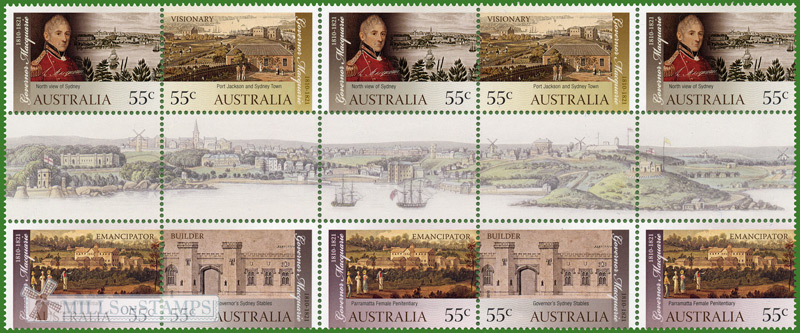
This reproduction also used in decoration of maxicard for this stamp. Please, look it here.
We bring also to your attention a full reproduction of this lithography:
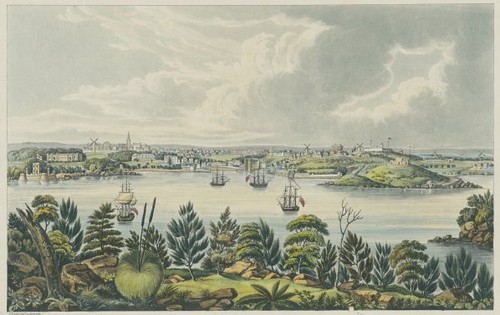
The image has been taken on a BibliOdyssey web page
-
Perforation type: 14 ½x13 ¾
Subject:
The booklet contains of 11 sheets with the large illustrations pictured on stamps and 4 souvenir sheets which contain of 4 stamps each.
Additional:
The first spread of the booklet with a reproduction of an engraving of 1812 "A north east view of Sydney, taken from the western part of Benne Long's Point"
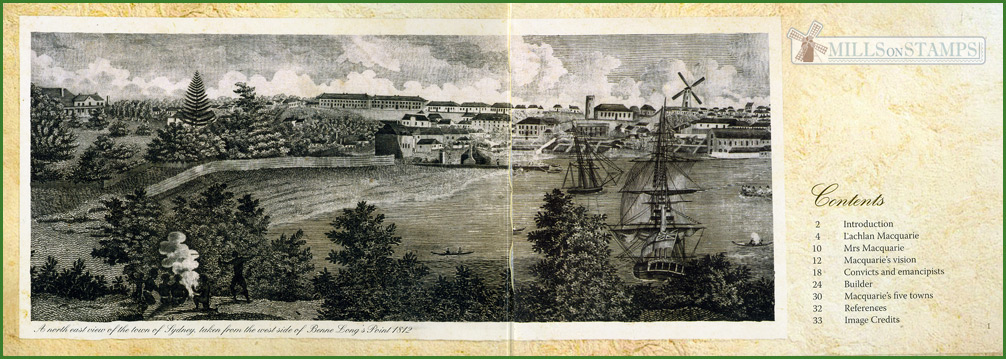
The sixth page of the booklet with the general design with the first souvenir sheet.

13-th page of the booklet with a reproduction of lithograph "The town ofSydney in New South Wales", 1821.
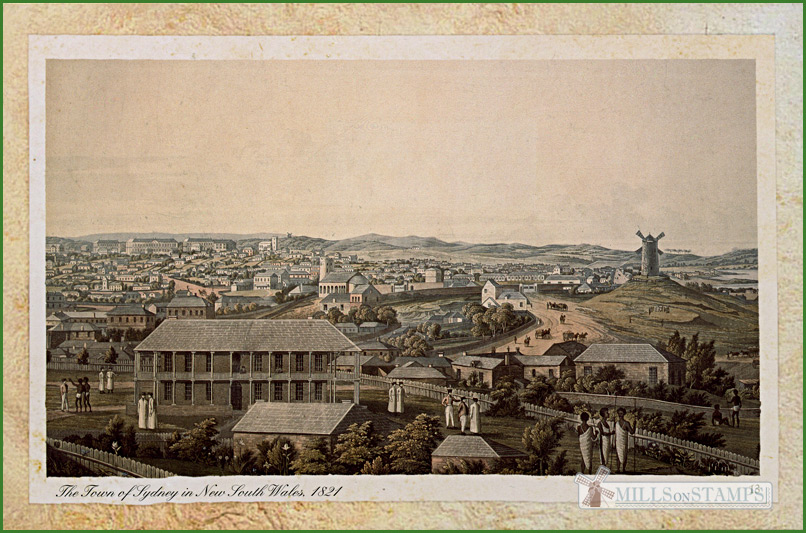
Second souvenir sheet. In the background is used James Taylor's reproduction "The entrance of Port Jackson and a part of the town of Sydney, New South Wales". On the stamp the part with a mill is cut out.

*Major-General Lachlan Macquarie CB (31 January 1762 – 1 July 1824), was a British military officer and colonial administrator. He served as the last autocratic Governor of New South Wales, Australia from 1810 to 1821 and had a leading role in the social, economic and architectural development of the colony. He is considered by some historians to have had a crucial influence on the transition of New South Wales from a penal colony to a free settlement and therefore to have played a major role in the shaping of Australian society in the early nineteenth century. An inscription on his tomb in Scotland describes him as "The Father of Australia".
Lachlan Macquarie was born on the island of Ulva off the coast of the Isle of Mull in the Inner Hebrides, a chain of islands off the West Coast of Scotland. Few details are known of either his father or his birthplace. His mother was the daughter of a Maclaine chieftain who owned a castle on the Isle of Mull. He left the island at the age of 14. If he did attend the Royal High School of Edinburgh, "as tradition has it", it was only for a very brief period because at the same age, he volunteered for the army.
In November 1807, Macquarie's cousin Elizabeth Henrietta Campbell became his second wife. In April 1809 Macquarie was appointed Governor of New South Wales. In making this appointment, the British government reversed its practice of appointing naval officers as governor and chose an army commander in the hope that he could secure the co-operation of the unruly New South Wales Corps. Macquarie was promoted to Colonel in 1810, Brigadier in 1811 and Major-General in 1813, while serving as governor.he started as a govenor on the 1 january 1810.
The first task Macquarie had to tackle was to restore orderly, lawful government and discipline in the colony following the Rum Rebellion against Governor William Bligh. Macquarie was ordered by the British government to arrest both John Macarthur and Major George Johnston, two of the leaders of the Rum Rebellion. However, by the time Macquarie arrived in Sydney in December 1809, both Macarthur and Johnston had already sailed for England to defend themselves. Macquarie immediately set about cancelling the various initiatives taken by the rebel government — for example, all "pardons, leases and land grants" made by the rebels were revoked.
Macquarie ruled the colony as an enlightened despot, breaking the power of the Army officers such as John Macarthur, who had been the colony's de facto ruler since Bligh's overthrow. He was "the last British proconsul sent to run New South Wales as a military autocracy".
In 1812, the first detailed inquiry into the convict system in Australia by a Select Committee on Transportation, supported in general Macquarie's liberal policies. However, the committee thought that fewer tickets of leave should be issued and opposed the governor having the power to grant pardons. The committee concluded that the colony should be made as prosperous as possible so as to provide work for the convicts and to encourage them to become settlers after being given their freedom.
On a visit of inspection to the settlement of Hobart Town on the Derwent River in Van Diemen's Land (now Tasmania) in November 1811, Macquarie was appalled at the ramshackle arrangement of the town and ordered the government surveyor James Meehan to survey a regular street layout. This survey determined the form of the current centre of the city of Hobart.
The end of the Napoleonic Wars in 1815 brought a renewed flood of both convicts and settlers to New South Wales, as the sea lanes became free and as the rate of unemployment and crime in Britain rose. Macquarie presided over a rapid increase in population and economic activity. By the time of his departure the white population had reached approximately 37,000. The colony began to have a life beyond its functions as a penal settlement, and an increasing proportion of the population earned their own living. All this, in Macquarie's eyes, made a new social policy necessary.Central to Macquarie's policy was his treatment of the emancipists: convicts whose sentences had expired or who had been given conditional or absolute pardons. By 1810 emancipists had outnumbered the free settlers, and Macquarie insisted that they be treated as social equals. He set the tone himself (some people hated it) by appointing emancipists to government positions: Francis Greenway as colonial architect and Dr William Redfern as colonial surgeon. He scandalised settler opinion by appointing an emancipist, Andrew Thompson, as a magistrate, and by inviting emancipists to tea at Government House. In exchange, Macquarie demanded that the ex-convicts live reformed (Christian) lives. He required that former convicts regularly attend church services, and in particular, strongly encouraged formal Christian (Anglican) marriages.
Macquarie was the greatest sponsor of exploration the colony had yet seen. In 1813 he sent Blaxland, Wentworth and Lawson across the Blue Mountains, where they found the great plains of the interior. There he ordered the establishment of Bathurst, Australia's first inland city. He appointed John Oxley as surveyor-general and sent him on expeditions up the coast of New South Wales and inland to find new rivers and new lands for settlement. Oxley discovered the rich Northern Rivers and New England regions of New South Wales, and in what is now Queensland he explored the present site of Brisbane.
The street layout of modern central Sydney is based upon a street plan established by Macquarie. The colony's most prestigious buildings were built on Macquarie Street. Some of these still stand today. What has survived of the Georgian 'Rum Hospital' serves as the Parliament House of the state of New South Wales. It is probable that the hospital was designed by Macquarie himself, in collaboration with his wife. The building's wide verandas were evidently inspired by Macquarie's familiarity with English colonial architecture in India. The elaborate stables which Macquarie commissioned for Government House are part of the modern structure housing the Sydney Conservatorium of Music. Both of these buildings were constructed by Macquarie in defiance of the British government's ban on expensive public building projects in the colony and reflect the tension between Macquarie's vision of Sydney as a Georgian city and the British government's view of the colony as a dumping ground for convicts to be financed as cheaply as possible.
The origin of the name "Australia" is closely associated with Macquarie. "Australia", as a name for the country which we now know by that name, was suggested by Matthew Flinders, but first used in an official despatch by Macquarie in 1817.
Macquarie's policies, especially his championing of the emancipists and the lavish expenditure of government money on public works, aroused opposition both in the colony and in London, where the government still saw New South Wales as fundamentally a penal colony. His statement, in a letter to the Colonial Secretary, that "free settlers in general... are by far the most discontented persons in the country" and that "emancipated convicts, or persons become free by servitude, made in many instances the best description of settlers", was much held against him.
Brass breast plate presented to the Aboriginal leader Coborn Jackey of the Burrowmunditory tribe by the squatter James White in the district of present day Young, New South Wales.
Macquarie is regarded as having been ambivalent towards the Australian Aborigines. He ordered punitive expeditions against the aborigines. However, when dealing with friendly tribes, he developed a strategy of nominating a 'chief' to be responsible for each of the clans, identified by the wearing of a brass breast-plate engraved with his name and title. Although this was a typically European way of negotiation, it often did reflect the actual status of elders within tribes.
Despite opposition from the British government, Macquarie encouraged the creation of the colony's first bank, the Bank of New South Wales, in 1817.________
This information has been taken from Wikipedia
Please, look also at first and second maxicard of this issue
Size (of sheet, booklet) mm: 158x104



